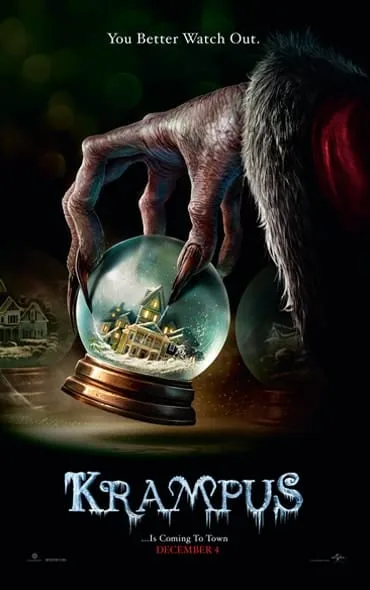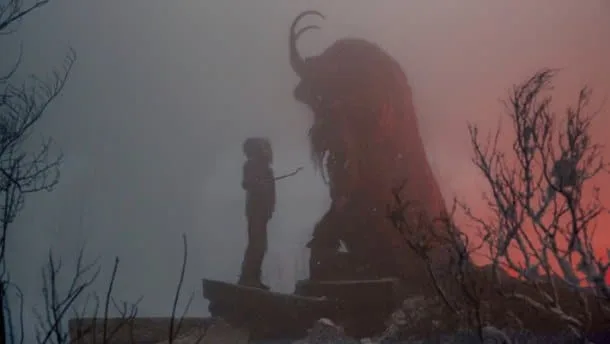By Keri O’Shea
Whilst horror films which centre around Xmas time are nothing new, in the past few years more and more filmmakers have started to pay attention to Xmas folklore: films such as Rare Exports (2010) had fun playing with the idea that Santa isn’t necessarily the sanitised, commercialised figure we now consider him to be; ditto the Dutch spin on Saint Nick as a bit of a bad ‘un, Sint (‘Saint’) which came out in the same year. It was surely only a matter of time before the figure of the Krampus got his own stint on our screens; after all, if you’re going to the trouble of representing the good guy as a bad guy, then why not use source material which has the bad guy already good to go? The Krampus is a scary looking figure: probably harking back to pre-Christian times in some way, shape or form, Germanic traditions pitch him as a cloven-footed, nasty piece of work who punishes wicked children (and young women, particularly – some of his incarnations are a little sexual in nature). Over the years he came to be associated with Christmas and Saint Nicholas, operating as the bad cop to his good cop; where the good children receive presents, bad children may end up faced with the Krampus instead, and varying accounts have him offering a piece of coal in lieu of a gift, thrashing the offending kids or even spiriting them away. Whatever it takes to get the entitled little shits to behave, quite frankly, but you have to admit the Krampus has an arresting image; of late, a fair few filmmakers have agreed, not least of which is Trick ‘r Treat director Michael Dougherty. I didn’t cotton on to this connection until I was on my way to see the film, quite honestly, but having loved Trick ‘r Treat I was quietly hopeful.

There is some good stuff going on here, with the early glimpses of the Krampus itself amongst the film’s strongest moments (less is definitely more) but by and large, Krampus is tonally all over the place. Kicking off along the lines of a National Lampoon style farce with a slow-mo fight at the local sales, the comedy approach dips when we get indoors and bear witness to the deeply awkward family exchanges, then it picks up again, then gives way to some pretty saccharin moments where an earnest little boy ponders the true spirit of Christmas. So far, so patchy. From here, the film tries to shift into what the BBFC would probably call ‘scenes of peril’; it starts reasonably well with this, with the alluded-to early scene as a high point, but then it seems like it wants to segue into the sort of camp, grisly fare beloved of films like Gremlins.
Still, though, it can’t quite commit itself to that either. The barrage of nasty gingerbread men and evil toys which provide nearly all of the ‘scenes of peril’ throughout the film – a strange choice, all told, given the title – are omnipotent in some cases and not much more than a bit of a nuisance in others, and the characters react to them differently every time (with some members of the family simply standing there as onlookers in some scenes). Then the film is bloodless enough to make it as a kiddie horror film, but lacks other elements which would qualify – but it’s just too kitsch and simplistic to really stand up as a horror film, or indeed a film which would appeal to an audience of adults. Hmm. And then there’s the figure of the Krampus himself. Having picked up on the association of the Krampus with Santa as Santa’s ‘dark half’, Dougherty has simply represented him as a dark Santa, which was a little underwhelming – especially as when the end credits roll, we’re treated to a plethora of old images of the Krampus, all of which would have made for more engrossing versions of the figure than the one we get.
For all of that, despite the issues, I did laugh a fair few times during this film. Any film which keeps up the momentum in terms of throwing silly creatures at you stands a good chance of being engaging, and the creature effects themselves are pretty good fun. For a Saturday night movie which raises questions that it doesn’t really matter go unanswered, Krampus fits the bill just fine, and it certainly looks the part as a festive film. However, given that the tone and the storytelling is rather lacking, I’d say a really good Krampus movie remains to be made, which is a shame, given the proven calibre of this film’s director.
Krampus (2015) is in UK cinemas now.
